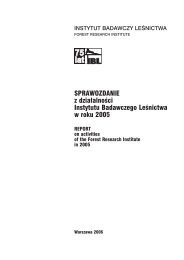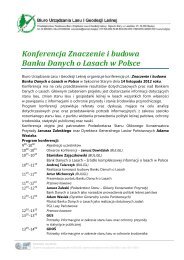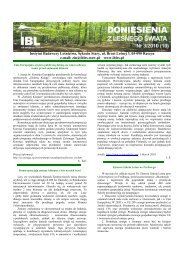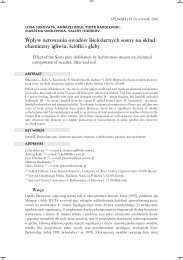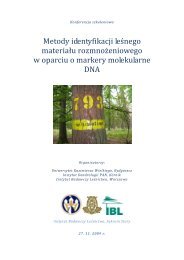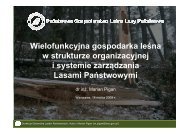Współczesne problemy ekonomiki leśnictwa - Instytut Badawczy ...
Współczesne problemy ekonomiki leśnictwa - Instytut Badawczy ...
Współczesne problemy ekonomiki leśnictwa - Instytut Badawczy ...
Create successful ePaper yourself
Turn your PDF publications into a flip-book with our unique Google optimized e-Paper software.
34<br />
WSPÓŁCZESNE PROBLEMY EKONOMIKI LEŚNICTWA<br />
się znacząco do podniesienia standardów podejmowania decyzji w zakresie dystrybucji<br />
zasobów oraz zwiększenia przejrzystości finansowania.<br />
Financing of Non-wood Forest Services<br />
by Ludek Šišak, Czech University of Agricultural Sciences Prague<br />
Forestry is generally considered as an important multifunctional activity with economic,<br />
ecological and social impacts on the society, reproducing and securing both market and<br />
non-market forest services. Support of multifunctional forestry activities, and especially<br />
financial aid, comes from different public sources both national and international.<br />
Under multifunctional concept of forestry and forest management, the economic<br />
effectiveness of forestry based on market timber production is considerably affected<br />
by claims of intensification of non-market forest services. Forestry, as a timber production<br />
activity, can be restricted to a great extent from different reasons, but especially for<br />
enhancement of non-market forest environmental services.<br />
It becomes more and more evident that forest market production (especially timber<br />
production) and occasionally other traditional forest market products will not be able to<br />
finance increasing demand of societies (public) for non-market forest services in individual<br />
countries. The supplying of such services usually enhances costs of production<br />
and reduces incomes from timber supplies. Therefore, forest owners and tenants have<br />
to look for other possibilities on how to include traditional non-market forest products<br />
and services into the market frame.<br />
There are several basic types of financial instruments used for supporting of nonmarket<br />
forest services, both direct and indirect, like grants, compensations, tax concessions,<br />
soft loans, purchase of forestland, purchase of forest services, research, information<br />
and advisory. The situation in supporting multifunctional forestry is rather complicated.<br />
There are many instruments of different kinds mutually interrelated. Financial<br />
means are coming to forestry from various sources and subsidy titles, both of national<br />
and international origin. Therefore, it is very difficult to create one effective transparent<br />
system supporting multifunctional forestry and consisting of both national and international<br />
sources.<br />
Financial means should be accounted and treated separately by their different social<br />
and economic essence, as:<br />
– subsidies proper, incentives as opposed to compensation for loss of profit;<br />
– compensations reimbursing financial losses due to a reduction in timber production<br />
as a result of social and environmental demands;<br />
– payments for the non-commercial uses of forests which benefit society, such as the<br />
environmental uses of woods and forests.<br />
It is desirable that reimbursements of economic loss caused by delivering of environmental<br />
services, and payments for purchase of non-market goods and services<br />
demanded by the society, are clearly separated from the subsidies (gifts, charity) and<br />
accounted for separately. This would contribute to a substantially higher standard of






